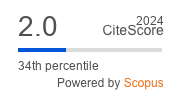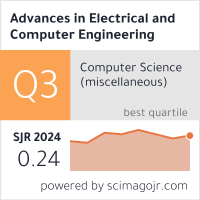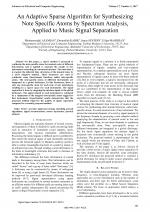| 2/2017 - 14 |
An Adaptive Sparse Algorithm for Synthesizing Note Specific Atoms by Spectrum Analysis, Applied to Music Signal SeparationAZAMIAN, M. |
| Extra paper information in |
| Click to see author's profile in |
| Download PDF |
Author keywords
adaptive algorithms, feature extraction, gaussian noise, hyperspectral imaging, image classification
References keywords
signal(18), separation(16), processing(16), audio(12), sparse(11), representation(10), music(10), source(9), speech(8), dictionaries(7)
Blue keywords are present in both the references section and the paper title.
About this article
Date of Publication: 2017-05-31
Volume 17, Issue 2, Year 2017, On page(s): 103 - 112
ISSN: 1582-7445, e-ISSN: 1844-7600
Digital Object Identifier: 10.4316/AECE.2017.02014
Web of Science Accession Number: 000405378100014
SCOPUS ID: 85020131730
Abstract
In this paper, a sparse method is proposed to synthesize the note-specific atoms for musical notes of different instruments, and is applied to separate the sounds of two instruments coexisting in a monaural mixture. The main idea is to explore the inherent time structures of the musical notes by a novel adaptive method. These structures are used to synthesize some time-domain functions called note-specific atoms. The note-specific atoms of different instruments are integrated in a global dictionary. In this dictionary, there is only one note-specific atom for each note of any instrument, resulting in a sparse space for each instrument. The signal separation is done by mapping the mixture signal to the global dictionary. The signal related to each instrument is estimated by a summation of the mapped note-specific atoms tagged for that instrument. Experimental results demonstrate that the proposed method improves the quality of signal separation compared to a recently proposed method. |
| References | | | Cited By «-- Click to see who has cited this paper |
| [1] A. Liutkus, J. L. Durrieu, L. Daudet, and G. Richard, "An overview of informed audio source separation," WIAMIS 2013, Paris, pp. 14, 2013. [CrossRef] [SCOPUS Times Cited 51] [2] H. B. Barlow, Possible Principles Underlying the Transformations of Sensory Messages, W. A. Rosenblith, Ed. The MIT Press, 2012, pp. 216234. [CrossRef] [3] N. Cho, C. C. J. Kuo, "Sparse representation of musical signals using source-specific dictionaries," IEEE Signal Processing Letters, vol. 17, no. 11, pp. 913-916, Nov. 2010. [CrossRef] [SCOPUS Times Cited 8] [4] R. Gribonval, M. Nielsen, "Sparse representations in unions of bases," IEEE Transactions on Information Theory, vol. 49, no. 12, pp. 33203325, Dec. 2003. [CrossRef] [SCOPUS Times Cited 727] [5] E. J. Candes, L. Demanet, "The curvelet representation of wave propagators is optimally sparse," Communications on Pure and Applied Mathematics, vol. 58, no. 11, pp. 14721528, Nov. 2005. [CrossRef] [SCOPUS Times Cited 261] [6] M. Yaghoobi, T. Blumensath, M. E. Davies, "Dictionary learning for sparse approximations with the majorization method," IEEE Transactions on Signal Processing, vol. 57, no. 6, pp. 21782191, Jun. 2009. [CrossRef] [SCOPUS Times Cited 181] [7] M. Aharon, M. Elad, A. Bruckstein, "rmK-SVD: An algorithm for designing overcomplete dictionaries for sparse representation," IEEE Transactions on Signal Processing, vol. 54, no. 11, pp. 43114322, Nov. 2006. [CrossRef] [SCOPUS Times Cited 9063] [8] H. Huang, J. Yu, W. Sun, "Super-resolution mapping via multi-dictionary based sparse representation," Int. Conf. on Acoustics Speech and Signal Processing, IEEE, Florence, 2014, pp. 3523-3527. [CrossRef] [SCOPUS Times Cited 51] [9] Y. Xu, G. Bao, X. Xu, Z.Ye, "Single-channel speech separation using sequential discriminative dictionary learning," Signal Processing, vol. 106, pp. 134140, Jan. 2015. [CrossRef] [SCOPUS Times Cited 19] [10] M. Yaghoobi, L. Daudet, M. E. Davies, "Parametric dictionary design for sparse coding," IEEE Trans. Signal Processing, vol. 57, no. 12, pp. 48004810, Dec. 2009. [CrossRef] [SCOPUS Times Cited 106] [11] M. Zibulevsky, B. A. Pearlmutter, "Blind source separation by sparse decomposition in a signal dictionary," Neural Computation, vol. 13, no. 4, pp. 863882, Apr. 2001. [CrossRef] [SCOPUS Times Cited 620] [12] M. M. Goodwin, M. Vetterli, "Matching pursuit and atomic signal models based on recursive filter banks," IEEE Transactions on Signal Processing, vol. 47, no. 7, pp. 18901902, Jul. 1999. [CrossRef] [SCOPUS Times Cited 107] [13] S. G. Mallat, Z. Zhang, "Matching pursuit with time-frequency dictionaries," IEEE Transactions on Signal Processing, vol. 41, no. 12, pp. 33973415, Dec. 1993. [CrossRef] [SCOPUS Times Cited 8449] [14] J. A. Tropp, "Greed is good: Algorithmic results for sparse approximation," IEEE Transactions on Information Theory, vol. 50, no. 10, pp. 22312242, Oct. 2004. [CrossRef] [SCOPUS Times Cited 2871] [15] C. Uhle, C. Dittmar, T. Sporer, "Extraction of drum tracks from polyphonic music using independent subspace analysis," in Proc. 4th Int. Symp. Ind. Compon. Anal. Blind Signal Separation, Nara, Japan, 2003, pp. 843848. ISBN: 4-9901531-1-1 [16] M. A. Casey, A. Westner, "Separation of mixed audio sources by independent subspace analysis," in Proc. Int. Compon. Music Conf., Berlin, Germany, 2000, pp. 154161. Permalink: http://hdl.handle.net/2027/spo.bbp2372.2000.142 [17] T. Virtanen, "Monaural sound source separation by nonnegative matrix factorization with temporal continuity and sparse criteria," IEEE Trans. Audio Speech Lang. Process., vol. 15, no. 3, pp. 10661074, Mar. 2007. [CrossRef] [SCOPUS Times Cited 891] [18] D. FitzGerald, Automatic drum transcription and source separation, Ph.D. dissertation, Dublin Inst. Technol., Dublin, Ireland, pp. 11-62, 2004. [19] G. J. Jang, T. W. Lee, Y. H. Oh, "Single-channel signal separation using time-domain basis functions," IEEE Signal Processing Letters, vol. 10, no.6, pp. 168-171, Jun. 2003. [CrossRef] [SCOPUS Times Cited 71] [20] K. Ellis, E. Coviello, A. B. Chan, and G. Lanckriet, "A Bag of Systems Representation for Music Auto-Tagging," IEEE Transactions on Audio, Speech, and Language Processing, vol. 21, no. 12, pp. 25542569, Dec. 2013. [CrossRef] [SCOPUS Times Cited 17] [21] S. Choi, A. Cichocki, H. M. Park, S. Y. Lee, "Blind source separation and independent component analysis: a review," Neural Information Processing-Letters and Reviews, vol. 6, no. 1, pp. 1-57, 2005. ISBN: 89-89453-04-6 [22] Y. Vaizman, B. McFee, G. Lanckriet, "Codebook-based audio feature representation for music information retrieval," IEEE/ACM Transactions on Audio, Speech, and Language Processing, vol. 22, no. 10, pp. 1483-1493, 2014. [CrossRef] [SCOPUS Times Cited 39] [23] N. Cho, Y. Shiu, C.-C. J. Kuo, "Audio Source Separation with Matching Pursuit and Content-Adaptive Dictionaries (MP-CAD)," 2007, pp. 287290. [CrossRef] [SCOPUS Times Cited 6] [24] N. Cho, Yu Shiu, and C.-C. J. Kuo, "Efficient music representation with content adaptive dictionaries," 2008, pp. 32543257. [CrossRef] [SCOPUS Times Cited 4] [25] P. Leveau, E. Vincent, G. Richard, and L. Daudet, "Instrument-Specific Harmonic Atoms for Mid-Level Music Representation," IEEE Transactions on Audio, Speech, and Language Processing, vol. 16, no. 1, pp. 116128, Jan. 2008. [CrossRef] [SCOPUS Times Cited 73] [26] B. L. Sturm, C. Roads, A. McLeran, J. J. Shynk, "Analysis, visualization, and transformation of audio signals using dictionary-based methods," Journal of New Music Research, vol. 38, no. 4, pp. 325341, Dec. 2009. [CrossRef] [SCOPUS Times Cited 15] [27] B. S. Kirei, M. D. Topa, I. Muresan, I. Homana, N. Toma, "Blind source separation for convolutive mixtures with neural networks," Advances in Electrical and Computer Engineering, vol. 11, no. 1, pp. 6368, 2011. [CrossRef] [Full Text] [SCOPUS Times Cited 4] [28] Z. Koldovsky, P. Tichavsky, "Time-domain blind separation of audio sources on the basis of a complete ICA decomposition of an observation space," IEEE Transactions on Audio, Speech, and Language Processing, vol. 19, no. 2, pp. 406416, Feb. 2011. [CrossRef] [SCOPUS Times Cited 42] [29] G. J. Jang and T. W. Lee, "A probabilistic approach to single channel blind signal separation," in Advances in Neural Information Processing Systems, Vancouver, BC, Canada, Dec. 2002, pp. 11781180. [30] Y. Yang, "Low-rank representation of both singing voice and music accompaniment via learned dictionaries," ISMIR, 2013, pp. 427-432. ISBN: 978-0-615-90065-0 [31] N. Cho, C. C. J. Kuo, "Sparse music representation with source-specific dictionaries and its application to signal separation," IEEE Transactions on Audio Speech Lang. Process., vol. 19, no. 2, pp. 337-348, Feb. 2011. [CrossRef] [SCOPUS Times Cited 23] [32] L. L. Scharf, C. Demeure, Statistical Signal Processing: Detection, Estimation, and Time Series Analysis, Addison-Wesley Pub. Co, 1991, pp.312-329. ISBN: 978-0201190380 [33] E. Vincent, S .Araki, P. Bofill, "The 2008 signal separation evaluation campaign: community-based approach to large-scale evaluation," in Independent Component Analysis and Signal Separation, vol. 5441, Springer Berlin Heidelberg, 2009, pp. 734-741. [CrossRef] [SCOPUS Times Cited 108] [34] M. Goto, H. Hashiguchi, T. Nishimura, R. Oka, "RWC music database: musical instrument sound database," ISMIR, 2003, pp. 229-230. [35] Universal Sound Bank [Online]. Available: http://eng.universal-soundbank.com/instruments.htm Web of Science® Citations for all references: 0 SCOPUS® Citations for all references: 23,807 TCR Web of Science® Average Citations per reference: 0 SCOPUS® Average Citations per reference: 661 ACR TCR = Total Citations for References / ACR = Average Citations per Reference We introduced in 2010 - for the first time in scientific publishing, the term "References Weight", as a quantitative indication of the quality ... Read more Citations for references updated on 2025-07-01 20:08 in 173 seconds. Note1: Web of Science® is a registered trademark of Clarivate Analytics. Note2: SCOPUS® is a registered trademark of Elsevier B.V. Disclaimer: All queries to the respective databases were made by using the DOI record of every reference (where available). Due to technical problems beyond our control, the information is not always accurate. Please use the CrossRef link to visit the respective publisher site. |
Faculty of Electrical Engineering and Computer Science
Stefan cel Mare University of Suceava, Romania
All rights reserved: Advances in Electrical and Computer Engineering is a registered trademark of the Stefan cel Mare University of Suceava. No part of this publication may be reproduced, stored in a retrieval system, photocopied, recorded or archived, without the written permission from the Editor. When authors submit their papers for publication, they agree that the copyright for their article be transferred to the Faculty of Electrical Engineering and Computer Science, Stefan cel Mare University of Suceava, Romania, if and only if the articles are accepted for publication. The copyright covers the exclusive rights to reproduce and distribute the article, including reprints and translations.
Permission for other use: The copyright owner's consent does not extend to copying for general distribution, for promotion, for creating new works, or for resale. Specific written permission must be obtained from the Editor for such copying. Direct linking to files hosted on this website is strictly prohibited.
Disclaimer: Whilst every effort is made by the publishers and editorial board to see that no inaccurate or misleading data, opinions or statements appear in this journal, they wish to make it clear that all information and opinions formulated in the articles, as well as linguistic accuracy, are the sole responsibility of the author.



